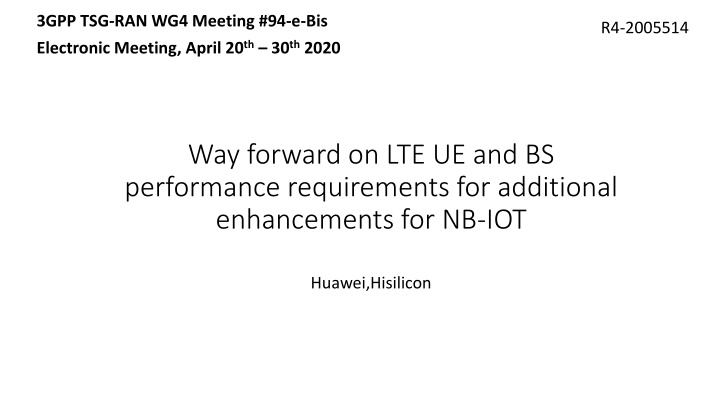Performance Requirements for LTE UE and BS Enhancements in NB-IoT
Define performance requirements for LTE UE and BS enhancements in NB-IoT by focusing on NPDSCH with interleaved multi-TB scheduling, test applicability rules, simulation results, and parameters for both UE and BS. Companies are encouraged to provide simulations based on specific assumptions to evaluate performance improvements, leading to the consideration of corresponding NPDSCH performance requirements. No demodulation requirements are needed for NB-IoT and NR coexistence.
Download Presentation

Please find below an Image/Link to download the presentation.
The content on the website is provided AS IS for your information and personal use only. It may not be sold, licensed, or shared on other websites without obtaining consent from the author.If you encounter any issues during the download, it is possible that the publisher has removed the file from their server.
You are allowed to download the files provided on this website for personal or commercial use, subject to the condition that they are used lawfully. All files are the property of their respective owners.
The content on the website is provided AS IS for your information and personal use only. It may not be sold, licensed, or shared on other websites without obtaining consent from the author.
E N D
Presentation Transcript
3GPP TSG-RAN WG4 Meeting #94-e-Bis Electronic Meeting, April 20th 30th2020 R4-2005514 Way forward on LTE UE and BS performance requirements for additional enhancements for NB-IOT Huawei,Hisilicon
Way forward on performance requirements UE FFS define NPDSCH performance requirements with interleaved multi-TB scheduling FFS define test applicability rule that if UE has passed the NPDSCH performance requirements with interleaved multi-TB scheduling, the test cases defined in section 8.12.1.1.3 and 8.12.1.2.3 of TS 36.101 for NPDSCH with continuous transmission can be skipped, if NPDSCH performance requirements for interleaved multi-TB agreed. Interested companies are encouraged to provide simulation results as per the simulation assumptions in slide#3. If performance improvements are observed as per the evaluation between the interleaved and continuous transmission, corresponding NPDSCH performance requirements definition can be considered. FFS the detailed parameters and test applicability if RAN4 will define the test case. BS FFS define performance requirements for NPUSCH format 1 with 2 HARQ processes and interleaved multi-TB scheduling Interested companies are encouraged to provide simulation results as per the simulation assumptions in slide#4 No need to introduce BS demodulation requirements for coexistence of NB-IoT and NR
Interested companies can provide simulations based on following simulation assumptions UE Other options are not precluded Parameter Value 200 kHz Stand alone 1T1R EPA 5Hz 0 Hz 0 s System bandwidth Operation mode Antenna configuration Channel model Frequency error Timing error Performance target NSF Repetition number Transmission mode HARQ process Carrier Type TB size Duplex mode SNR@70% of maximum throughput 4 32 Interleaved, Continuous 2 Anchor 616 FDD
Interested companies can provide simulations based on following simulation assumptions BS Other options are not precluded Parameter Number of tones SCS Antenna configuration Channel model Frequency error Timing error Performance target NRU Repetition number HARQ process Transmission mode TB size Value 12 15kHz 1T2R ETU 1Hz 0Hz 0 s SNR@ 70% of maximum throughput 1 16 or 32 2 Interleaved, continuous 136























